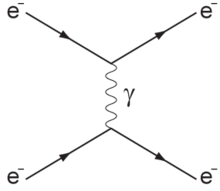
Scattering
Scattering is a general physical process where some forms of radiation, such as light, sound, or moving particles, are forced to deviate from a straight trajectory by one or more paths due to localized non-uniformities in the medium through which they pass. In conventional use, this also includes deviation of reflected radiation from the angle predicted by the law of reflection. Reflections that undergo scattering are often called diffuse reflections and unscattered reflections are called specular (mirror-like) reflections.
Scattering may also refer to particle-particle collisions between molecules, atoms, electrons, photons and other particles. Examples are: cosmic rays scattering by the Earth's upper atmosphere; particle collisions inside particle accelerators; electron scattering by gas atoms in fluorescent lamps; and neutron scattering inside nuclear reactors.
The types of non-uniformities which can cause scattering, sometimes known as scatterers or scattering centers, are too numerous to list, but a small sample includes particles, bubbles, droplets, density fluctuations in fluids, crystallites in polycrystalline solids, defects in monocrystalline solids, surface roughness, cells in organisms, and textile fibers in clothing. The effects of such features on the path of almost any type of propagating wave or moving particle can be described in the framework of scattering theory.
Statistical dispersion
In statistics, dispersion (also called variability, scatter, or spread) denotes how stretched or squeezed a distribution (theoretical or that underlying a statistical sample) is. Common examples of measures of statistical dispersion are the variance, standard deviation and interquartile range.
Dispersion is contrasted with location or central tendency, and together they are the most used properties of distributions.
Measures of statistical dispersion
A measure of statistical dispersion is a nonnegative real number that is zero if all the data are the same and increases as the data become more diverse.
Most measures of dispersion have the same units as the quantity being measured. In other words, if the measurements are in metres or seconds, so is the measure of dispersion. Such measures of dispersion include:

Dune (franchise)
Dune is a science fiction franchise that originated with the 1965 novel Dune by Frank Herbert. Dune is frequently cited as the best-selling science fiction novel in history. It won the 1966 Hugo Award and the inaugural Nebula Award for Best Novel, and was later adapted into a 1984 film as well as a 2000 television miniseries. Herbert wrote five sequels, and the first two were presented as a miniseries in 2003. The Dune universe has also inspired some traditional games and a series of video games. Since 2009, the names of planets from the Dune novels have been adopted for the real-world nomenclature of plains and other features on Saturn's moon Titan.
Frank Herbert died in 1986. Beginning in 1999, his son Brian Herbert and science fiction author Kevin J. Anderson published a number of prequel novels, as well as two which complete the original Dune series—Hunters of Dune (2006) and Sandworms of Dune (2007)—partially based on Frank Herbert's notes discovered a decade after his death.

Gel
A gel (coined by 19th-century Scottish chemist Thomas Graham, by clipping from gelatine) is a solid, jelly-like material that can have properties ranging from soft and weak to hard and tough. Gels are defined as a substantially dilute cross-linked system, which exhibits no flow when in the steady-state. By weight, gels are mostly liquid, yet they behave like solids due to a three-dimensional cross-linked network within the liquid. It is the crosslinking within the fluid that give a gel its structure (hardness) and contribute to the adhesive stick (tack). In this way gels are a dispersion of molecules of a liquid within a solid in which the solid is the continuous phase and the liquid is the discontinuous phase.
Gel: Nonfluid colloidal network or polymer network that is expanded throughout its whole volume by a fluid.
Note 1: A gel has a finite, usually rather small, yield stress.
Note 2: A gel can contain:
Note 3: Corrected from ref., where the definition is via the property identified in Note 1 (above) rather than of the structural characteristics that describe a gel.

Color gel
A color gel or color filter (British spelling: colour gel or colour filter), also known as lighting gel or simply gel, is a transparent colored material that is used in theater, event production, photography, videography and cinematography to color light and for color correction. Modern gels are thin sheets of polycarbonate or polyester, placed in front of a lighting fixture in the path of the beam.
Gels have a limited life, especially in saturated colors. The color will fade or even melt, depending upon the energy absorption of the color, and the sheet will have to be replaced. In permanent installations and some theatrical uses, colored glass filters or dichroic filters are being used. The main drawbacks are additional expense and a more limited selection.
History

Gelatin dessert
Gelatin desserts are desserts made with sweetened and flavored gelatin.
They can be made by combining plain gelatin with other ingredients or by using a premixed blend of gelatin with additives. Fully prepared gelatin desserts are sold in a variety of forms, ranging from large decorative shapes to individual serving cups.
Regional names
Brands
Popular brands of premixed gelatin include:
History
Before gelatin became widely available as a commercial product, the most typical gelatin dessert was "calf's foot jelly". As the name indicates, this was made by extracting and purifying gelatin from the foot of a calf. This gelatin was then mixed with fruit juice and sugar.
Podcasts:

